Employee Relations and Voice: A Review of Research
VerifiedAdded on 2020/07/22
|16
|5587
|129
AI Summary
This assignment reviews various studies on employee voice, HRM practices, and their effects on organizational performance. It covers topics such as employee engagement, industrial relations climate, managerial attitudes to unions, and the role of HR line management. The review also touches on employee readiness for organizational change, supervisor and peer relations, and demographic factors. Additionally, it explores the relationship between HR formality and employee job quality, and discusses the impact of stakeholder theory on industrial relations.
Contribute Materials
Your contribution can guide someone’s learning journey. Share your
documents today.
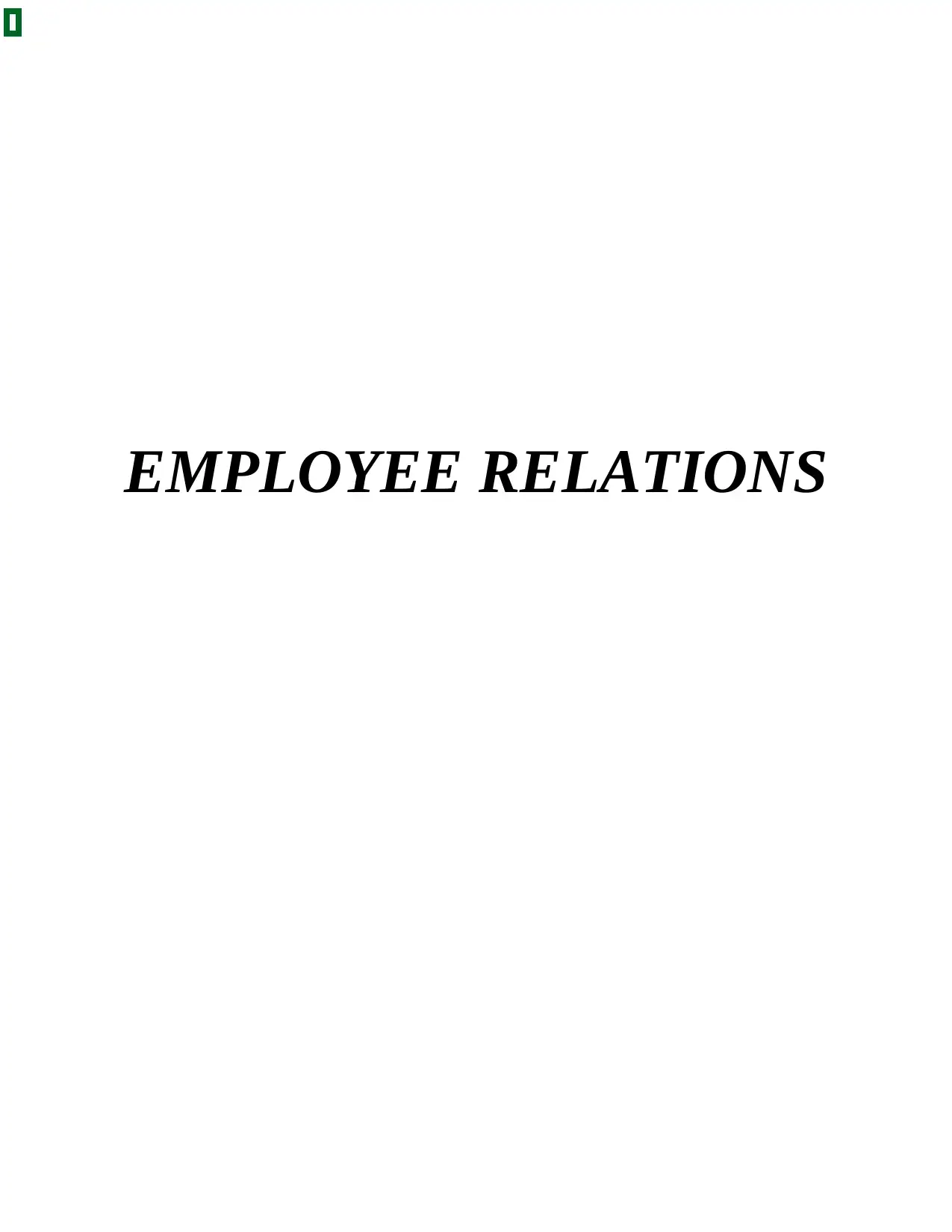
EMPLOYEE RELATIONS
Secure Best Marks with AI Grader
Need help grading? Try our AI Grader for instant feedback on your assignments.
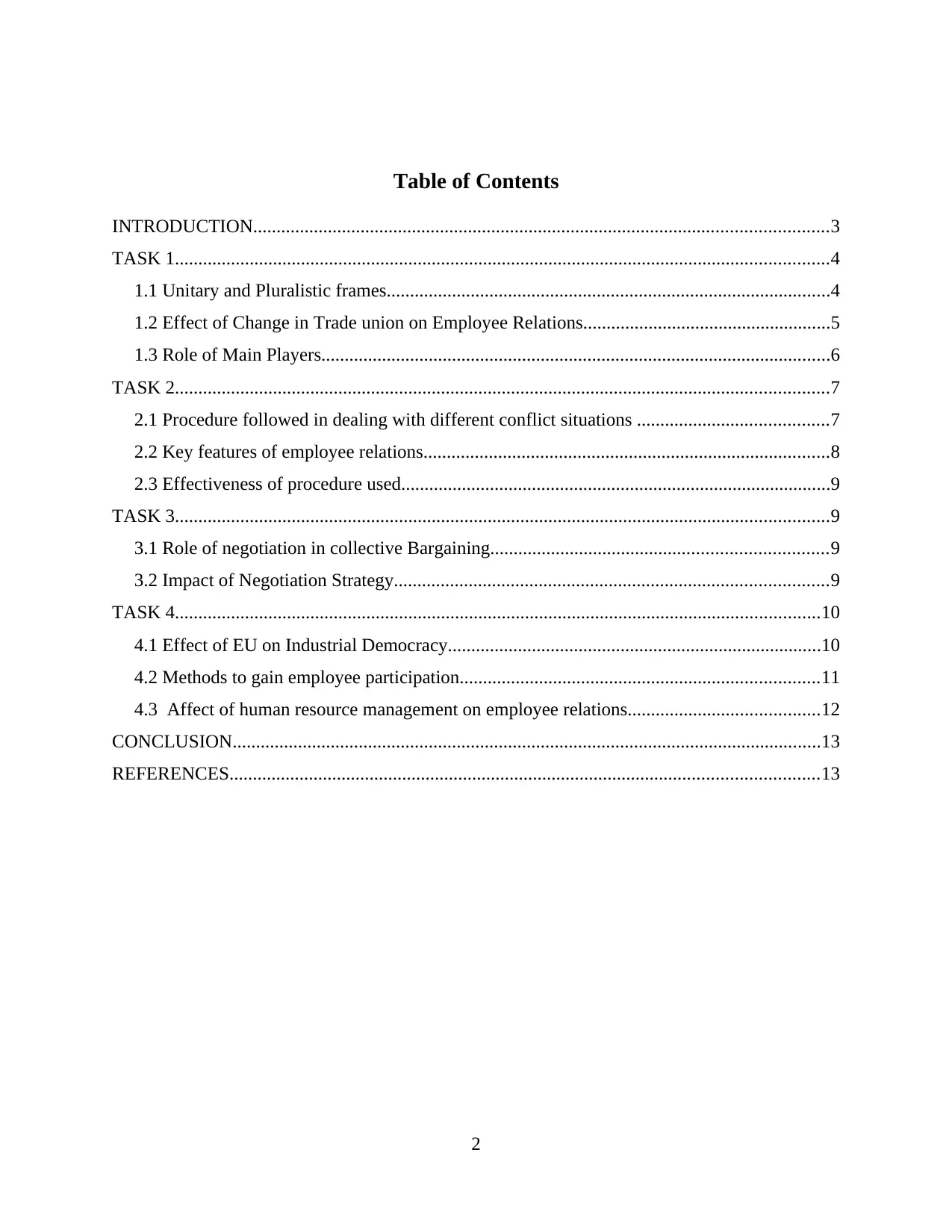
Table of Contents
INTRODUCTION...........................................................................................................................3
TASK 1............................................................................................................................................4
1.1 Unitary and Pluralistic frames...............................................................................................4
1.2 Effect of Change in Trade union on Employee Relations.....................................................5
1.3 Role of Main Players.............................................................................................................6
TASK 2............................................................................................................................................7
2.1 Procedure followed in dealing with different conflict situations .........................................7
2.2 Key features of employee relations.......................................................................................8
2.3 Effectiveness of procedure used............................................................................................9
TASK 3............................................................................................................................................9
3.1 Role of negotiation in collective Bargaining........................................................................9
3.2 Impact of Negotiation Strategy.............................................................................................9
TASK 4..........................................................................................................................................10
4.1 Effect of EU on Industrial Democracy................................................................................10
4.2 Methods to gain employee participation.............................................................................11
4.3 Affect of human resource management on employee relations.........................................12
CONCLUSION..............................................................................................................................13
REFERENCES..............................................................................................................................13
2
INTRODUCTION...........................................................................................................................3
TASK 1............................................................................................................................................4
1.1 Unitary and Pluralistic frames...............................................................................................4
1.2 Effect of Change in Trade union on Employee Relations.....................................................5
1.3 Role of Main Players.............................................................................................................6
TASK 2............................................................................................................................................7
2.1 Procedure followed in dealing with different conflict situations .........................................7
2.2 Key features of employee relations.......................................................................................8
2.3 Effectiveness of procedure used............................................................................................9
TASK 3............................................................................................................................................9
3.1 Role of negotiation in collective Bargaining........................................................................9
3.2 Impact of Negotiation Strategy.............................................................................................9
TASK 4..........................................................................................................................................10
4.1 Effect of EU on Industrial Democracy................................................................................10
4.2 Methods to gain employee participation.............................................................................11
4.3 Affect of human resource management on employee relations.........................................12
CONCLUSION..............................................................................................................................13
REFERENCES..............................................................................................................................13
2
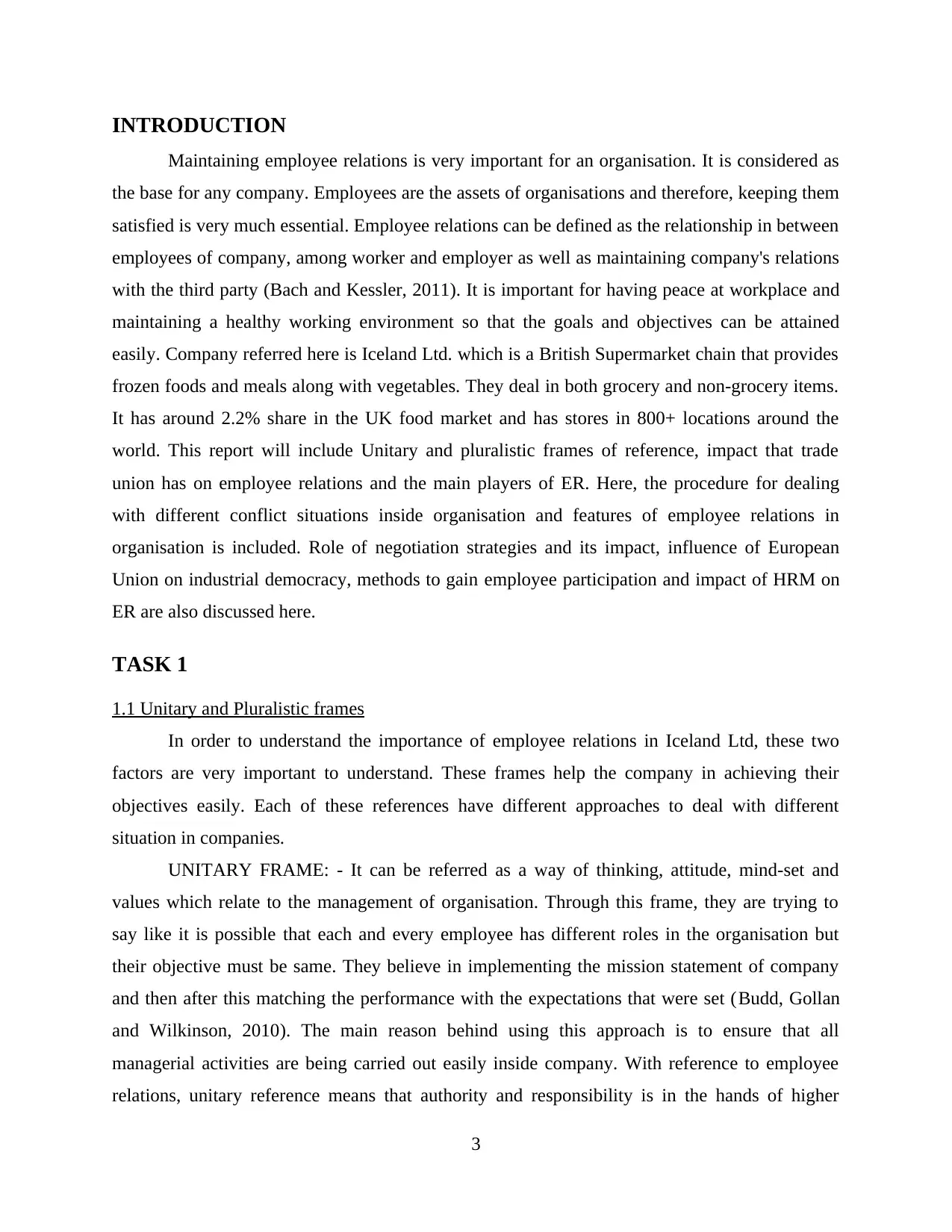
INTRODUCTION
Maintaining employee relations is very important for an organisation. It is considered as
the base for any company. Employees are the assets of organisations and therefore, keeping them
satisfied is very much essential. Employee relations can be defined as the relationship in between
employees of company, among worker and employer as well as maintaining company's relations
with the third party (Bach and Kessler, 2011). It is important for having peace at workplace and
maintaining a healthy working environment so that the goals and objectives can be attained
easily. Company referred here is Iceland Ltd. which is a British Supermarket chain that provides
frozen foods and meals along with vegetables. They deal in both grocery and non-grocery items.
It has around 2.2% share in the UK food market and has stores in 800+ locations around the
world. This report will include Unitary and pluralistic frames of reference, impact that trade
union has on employee relations and the main players of ER. Here, the procedure for dealing
with different conflict situations inside organisation and features of employee relations in
organisation is included. Role of negotiation strategies and its impact, influence of European
Union on industrial democracy, methods to gain employee participation and impact of HRM on
ER are also discussed here.
TASK 1
1.1 Unitary and Pluralistic frames
In order to understand the importance of employee relations in Iceland Ltd, these two
factors are very important to understand. These frames help the company in achieving their
objectives easily. Each of these references have different approaches to deal with different
situation in companies.
UNITARY FRAME: - It can be referred as a way of thinking, attitude, mind-set and
values which relate to the management of organisation. Through this frame, they are trying to
say like it is possible that each and every employee has different roles in the organisation but
their objective must be same. They believe in implementing the mission statement of company
and then after this matching the performance with the expectations that were set (Budd, Gollan
and Wilkinson, 2010). The main reason behind using this approach is to ensure that all
managerial activities are being carried out easily inside company. With reference to employee
relations, unitary reference means that authority and responsibility is in the hands of higher
3
Maintaining employee relations is very important for an organisation. It is considered as
the base for any company. Employees are the assets of organisations and therefore, keeping them
satisfied is very much essential. Employee relations can be defined as the relationship in between
employees of company, among worker and employer as well as maintaining company's relations
with the third party (Bach and Kessler, 2011). It is important for having peace at workplace and
maintaining a healthy working environment so that the goals and objectives can be attained
easily. Company referred here is Iceland Ltd. which is a British Supermarket chain that provides
frozen foods and meals along with vegetables. They deal in both grocery and non-grocery items.
It has around 2.2% share in the UK food market and has stores in 800+ locations around the
world. This report will include Unitary and pluralistic frames of reference, impact that trade
union has on employee relations and the main players of ER. Here, the procedure for dealing
with different conflict situations inside organisation and features of employee relations in
organisation is included. Role of negotiation strategies and its impact, influence of European
Union on industrial democracy, methods to gain employee participation and impact of HRM on
ER are also discussed here.
TASK 1
1.1 Unitary and Pluralistic frames
In order to understand the importance of employee relations in Iceland Ltd, these two
factors are very important to understand. These frames help the company in achieving their
objectives easily. Each of these references have different approaches to deal with different
situation in companies.
UNITARY FRAME: - It can be referred as a way of thinking, attitude, mind-set and
values which relate to the management of organisation. Through this frame, they are trying to
say like it is possible that each and every employee has different roles in the organisation but
their objective must be same. They believe in implementing the mission statement of company
and then after this matching the performance with the expectations that were set (Budd, Gollan
and Wilkinson, 2010). The main reason behind using this approach is to ensure that all
managerial activities are being carried out easily inside company. With reference to employee
relations, unitary reference means that authority and responsibility is in the hands of higher
3
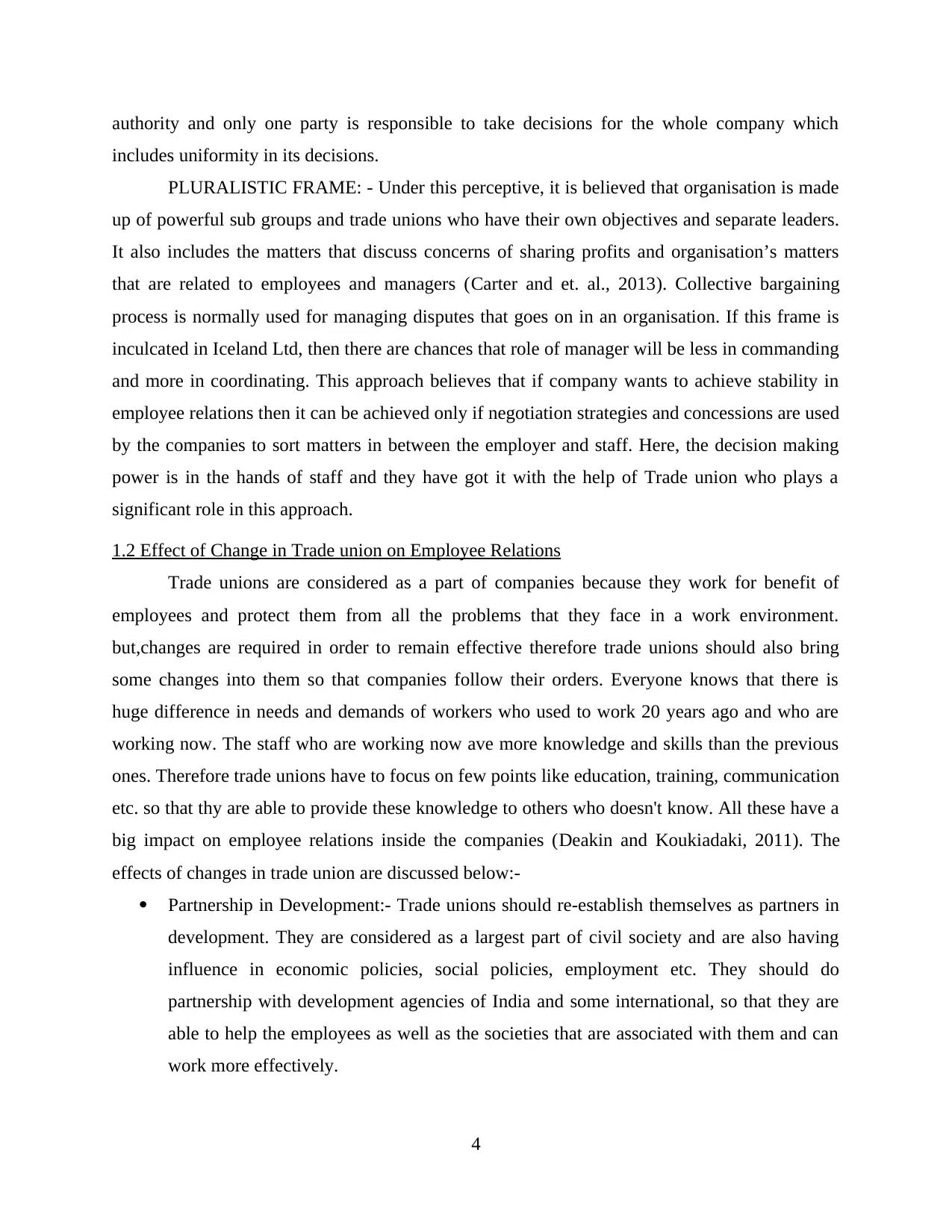
authority and only one party is responsible to take decisions for the whole company which
includes uniformity in its decisions.
PLURALISTIC FRAME: - Under this perceptive, it is believed that organisation is made
up of powerful sub groups and trade unions who have their own objectives and separate leaders.
It also includes the matters that discuss concerns of sharing profits and organisation’s matters
that are related to employees and managers (Carter and et. al., 2013). Collective bargaining
process is normally used for managing disputes that goes on in an organisation. If this frame is
inculcated in Iceland Ltd, then there are chances that role of manager will be less in commanding
and more in coordinating. This approach believes that if company wants to achieve stability in
employee relations then it can be achieved only if negotiation strategies and concessions are used
by the companies to sort matters in between the employer and staff. Here, the decision making
power is in the hands of staff and they have got it with the help of Trade union who plays a
significant role in this approach.
1.2 Effect of Change in Trade union on Employee Relations
Trade unions are considered as a part of companies because they work for benefit of
employees and protect them from all the problems that they face in a work environment.
but,changes are required in order to remain effective therefore trade unions should also bring
some changes into them so that companies follow their orders. Everyone knows that there is
huge difference in needs and demands of workers who used to work 20 years ago and who are
working now. The staff who are working now ave more knowledge and skills than the previous
ones. Therefore trade unions have to focus on few points like education, training, communication
etc. so that thy are able to provide these knowledge to others who doesn't know. All these have a
big impact on employee relations inside the companies (Deakin and Koukiadaki, 2011). The
effects of changes in trade union are discussed below:-
Partnership in Development:- Trade unions should re-establish themselves as partners in
development. They are considered as a largest part of civil society and are also having
influence in economic policies, social policies, employment etc. They should do
partnership with development agencies of India and some international, so that they are
able to help the employees as well as the societies that are associated with them and can
work more effectively.
4
includes uniformity in its decisions.
PLURALISTIC FRAME: - Under this perceptive, it is believed that organisation is made
up of powerful sub groups and trade unions who have their own objectives and separate leaders.
It also includes the matters that discuss concerns of sharing profits and organisation’s matters
that are related to employees and managers (Carter and et. al., 2013). Collective bargaining
process is normally used for managing disputes that goes on in an organisation. If this frame is
inculcated in Iceland Ltd, then there are chances that role of manager will be less in commanding
and more in coordinating. This approach believes that if company wants to achieve stability in
employee relations then it can be achieved only if negotiation strategies and concessions are used
by the companies to sort matters in between the employer and staff. Here, the decision making
power is in the hands of staff and they have got it with the help of Trade union who plays a
significant role in this approach.
1.2 Effect of Change in Trade union on Employee Relations
Trade unions are considered as a part of companies because they work for benefit of
employees and protect them from all the problems that they face in a work environment.
but,changes are required in order to remain effective therefore trade unions should also bring
some changes into them so that companies follow their orders. Everyone knows that there is
huge difference in needs and demands of workers who used to work 20 years ago and who are
working now. The staff who are working now ave more knowledge and skills than the previous
ones. Therefore trade unions have to focus on few points like education, training, communication
etc. so that thy are able to provide these knowledge to others who doesn't know. All these have a
big impact on employee relations inside the companies (Deakin and Koukiadaki, 2011). The
effects of changes in trade union are discussed below:-
Partnership in Development:- Trade unions should re-establish themselves as partners in
development. They are considered as a largest part of civil society and are also having
influence in economic policies, social policies, employment etc. They should do
partnership with development agencies of India and some international, so that they are
able to help the employees as well as the societies that are associated with them and can
work more effectively.
4
Secure Best Marks with AI Grader
Need help grading? Try our AI Grader for instant feedback on your assignments.
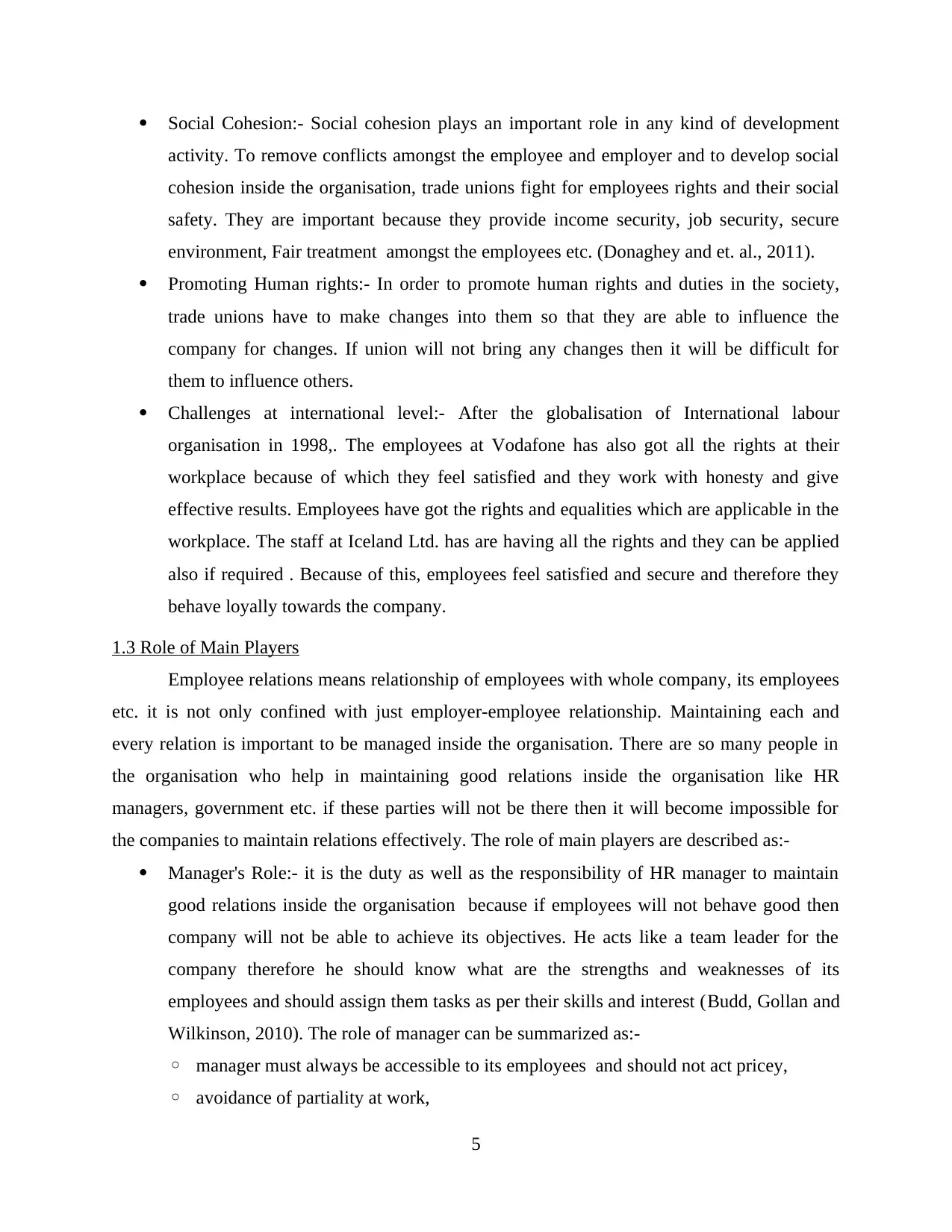
Social Cohesion:- Social cohesion plays an important role in any kind of development
activity. To remove conflicts amongst the employee and employer and to develop social
cohesion inside the organisation, trade unions fight for employees rights and their social
safety. They are important because they provide income security, job security, secure
environment, Fair treatment amongst the employees etc. (Donaghey and et. al., 2011).
Promoting Human rights:- In order to promote human rights and duties in the society,
trade unions have to make changes into them so that they are able to influence the
company for changes. If union will not bring any changes then it will be difficult for
them to influence others.
Challenges at international level:- After the globalisation of International labour
organisation in 1998,. The employees at Vodafone has also got all the rights at their
workplace because of which they feel satisfied and they work with honesty and give
effective results. Employees have got the rights and equalities which are applicable in the
workplace. The staff at Iceland Ltd. has are having all the rights and they can be applied
also if required . Because of this, employees feel satisfied and secure and therefore they
behave loyally towards the company.
1.3 Role of Main Players
Employee relations means relationship of employees with whole company, its employees
etc. it is not only confined with just employer-employee relationship. Maintaining each and
every relation is important to be managed inside the organisation. There are so many people in
the organisation who help in maintaining good relations inside the organisation like HR
managers, government etc. if these parties will not be there then it will become impossible for
the companies to maintain relations effectively. The role of main players are described as:-
Manager's Role:- it is the duty as well as the responsibility of HR manager to maintain
good relations inside the organisation because if employees will not behave good then
company will not be able to achieve its objectives. He acts like a team leader for the
company therefore he should know what are the strengths and weaknesses of its
employees and should assign them tasks as per their skills and interest (Budd, Gollan and
Wilkinson, 2010). The role of manager can be summarized as:-
◦ manager must always be accessible to its employees and should not act pricey,
◦ avoidance of partiality at work,
5
activity. To remove conflicts amongst the employee and employer and to develop social
cohesion inside the organisation, trade unions fight for employees rights and their social
safety. They are important because they provide income security, job security, secure
environment, Fair treatment amongst the employees etc. (Donaghey and et. al., 2011).
Promoting Human rights:- In order to promote human rights and duties in the society,
trade unions have to make changes into them so that they are able to influence the
company for changes. If union will not bring any changes then it will be difficult for
them to influence others.
Challenges at international level:- After the globalisation of International labour
organisation in 1998,. The employees at Vodafone has also got all the rights at their
workplace because of which they feel satisfied and they work with honesty and give
effective results. Employees have got the rights and equalities which are applicable in the
workplace. The staff at Iceland Ltd. has are having all the rights and they can be applied
also if required . Because of this, employees feel satisfied and secure and therefore they
behave loyally towards the company.
1.3 Role of Main Players
Employee relations means relationship of employees with whole company, its employees
etc. it is not only confined with just employer-employee relationship. Maintaining each and
every relation is important to be managed inside the organisation. There are so many people in
the organisation who help in maintaining good relations inside the organisation like HR
managers, government etc. if these parties will not be there then it will become impossible for
the companies to maintain relations effectively. The role of main players are described as:-
Manager's Role:- it is the duty as well as the responsibility of HR manager to maintain
good relations inside the organisation because if employees will not behave good then
company will not be able to achieve its objectives. He acts like a team leader for the
company therefore he should know what are the strengths and weaknesses of its
employees and should assign them tasks as per their skills and interest (Budd, Gollan and
Wilkinson, 2010). The role of manager can be summarized as:-
◦ manager must always be accessible to its employees and should not act pricey,
◦ avoidance of partiality at work,
5
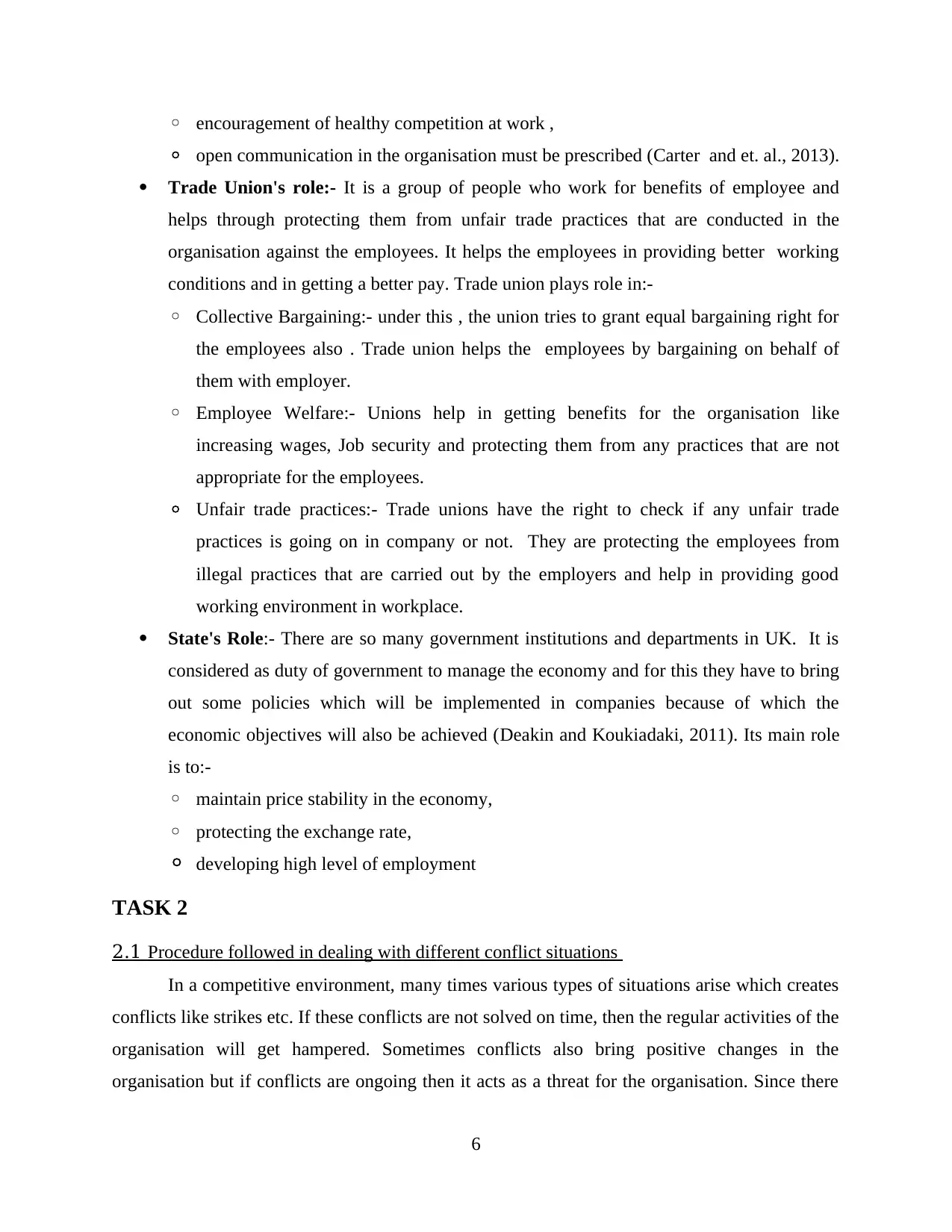
◦ encouragement of healthy competition at work ,
◦ open communication in the organisation must be prescribed (Carter and et. al., 2013).
Trade Union's role:- It is a group of people who work for benefits of employee and
helps through protecting them from unfair trade practices that are conducted in the
organisation against the employees. It helps the employees in providing better working
conditions and in getting a better pay. Trade union plays role in:-
◦ Collective Bargaining:- under this , the union tries to grant equal bargaining right for
the employees also . Trade union helps the employees by bargaining on behalf of
them with employer.
◦ Employee Welfare:- Unions help in getting benefits for the organisation like
increasing wages, Job security and protecting them from any practices that are not
appropriate for the employees.
◦ Unfair trade practices:- Trade unions have the right to check if any unfair trade
practices is going on in company or not. They are protecting the employees from
illegal practices that are carried out by the employers and help in providing good
working environment in workplace.
State's Role:- There are so many government institutions and departments in UK. It is
considered as duty of government to manage the economy and for this they have to bring
out some policies which will be implemented in companies because of which the
economic objectives will also be achieved (Deakin and Koukiadaki, 2011). Its main role
is to:-
◦ maintain price stability in the economy,
◦ protecting the exchange rate,
◦ developing high level of employment
TASK 2
2.1 Procedure followed in dealing with different conflict situations
In a competitive environment, many times various types of situations arise which creates
conflicts like strikes etc. If these conflicts are not solved on time, then the regular activities of the
organisation will get hampered. Sometimes conflicts also bring positive changes in the
organisation but if conflicts are ongoing then it acts as a threat for the organisation. Since there
6
◦ open communication in the organisation must be prescribed (Carter and et. al., 2013).
Trade Union's role:- It is a group of people who work for benefits of employee and
helps through protecting them from unfair trade practices that are conducted in the
organisation against the employees. It helps the employees in providing better working
conditions and in getting a better pay. Trade union plays role in:-
◦ Collective Bargaining:- under this , the union tries to grant equal bargaining right for
the employees also . Trade union helps the employees by bargaining on behalf of
them with employer.
◦ Employee Welfare:- Unions help in getting benefits for the organisation like
increasing wages, Job security and protecting them from any practices that are not
appropriate for the employees.
◦ Unfair trade practices:- Trade unions have the right to check if any unfair trade
practices is going on in company or not. They are protecting the employees from
illegal practices that are carried out by the employers and help in providing good
working environment in workplace.
State's Role:- There are so many government institutions and departments in UK. It is
considered as duty of government to manage the economy and for this they have to bring
out some policies which will be implemented in companies because of which the
economic objectives will also be achieved (Deakin and Koukiadaki, 2011). Its main role
is to:-
◦ maintain price stability in the economy,
◦ protecting the exchange rate,
◦ developing high level of employment
TASK 2
2.1 Procedure followed in dealing with different conflict situations
In a competitive environment, many times various types of situations arise which creates
conflicts like strikes etc. If these conflicts are not solved on time, then the regular activities of the
organisation will get hampered. Sometimes conflicts also bring positive changes in the
organisation but if conflicts are ongoing then it acts as a threat for the organisation. Since there
6
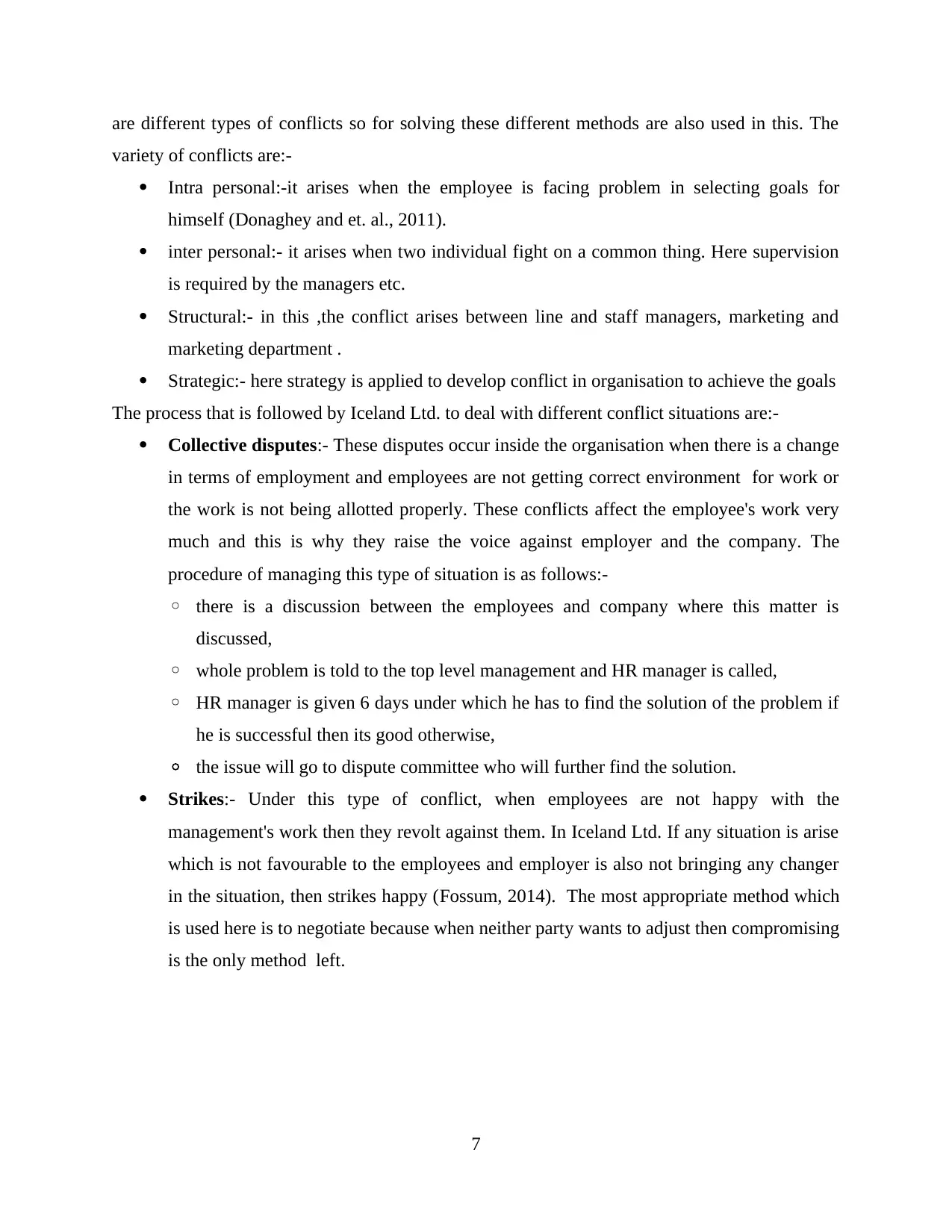
are different types of conflicts so for solving these different methods are also used in this. The
variety of conflicts are:-
Intra personal:-it arises when the employee is facing problem in selecting goals for
himself (Donaghey and et. al., 2011).
inter personal:- it arises when two individual fight on a common thing. Here supervision
is required by the managers etc.
Structural:- in this ,the conflict arises between line and staff managers, marketing and
marketing department .
Strategic:- here strategy is applied to develop conflict in organisation to achieve the goals
The process that is followed by Iceland Ltd. to deal with different conflict situations are:-
Collective disputes:- These disputes occur inside the organisation when there is a change
in terms of employment and employees are not getting correct environment for work or
the work is not being allotted properly. These conflicts affect the employee's work very
much and this is why they raise the voice against employer and the company. The
procedure of managing this type of situation is as follows:-
◦ there is a discussion between the employees and company where this matter is
discussed,
◦ whole problem is told to the top level management and HR manager is called,
◦ HR manager is given 6 days under which he has to find the solution of the problem if
he is successful then its good otherwise,
◦ the issue will go to dispute committee who will further find the solution.
Strikes:- Under this type of conflict, when employees are not happy with the
management's work then they revolt against them. In Iceland Ltd. If any situation is arise
which is not favourable to the employees and employer is also not bringing any changer
in the situation, then strikes happy (Fossum, 2014). The most appropriate method which
is used here is to negotiate because when neither party wants to adjust then compromising
is the only method left.
7
variety of conflicts are:-
Intra personal:-it arises when the employee is facing problem in selecting goals for
himself (Donaghey and et. al., 2011).
inter personal:- it arises when two individual fight on a common thing. Here supervision
is required by the managers etc.
Structural:- in this ,the conflict arises between line and staff managers, marketing and
marketing department .
Strategic:- here strategy is applied to develop conflict in organisation to achieve the goals
The process that is followed by Iceland Ltd. to deal with different conflict situations are:-
Collective disputes:- These disputes occur inside the organisation when there is a change
in terms of employment and employees are not getting correct environment for work or
the work is not being allotted properly. These conflicts affect the employee's work very
much and this is why they raise the voice against employer and the company. The
procedure of managing this type of situation is as follows:-
◦ there is a discussion between the employees and company where this matter is
discussed,
◦ whole problem is told to the top level management and HR manager is called,
◦ HR manager is given 6 days under which he has to find the solution of the problem if
he is successful then its good otherwise,
◦ the issue will go to dispute committee who will further find the solution.
Strikes:- Under this type of conflict, when employees are not happy with the
management's work then they revolt against them. In Iceland Ltd. If any situation is arise
which is not favourable to the employees and employer is also not bringing any changer
in the situation, then strikes happy (Fossum, 2014). The most appropriate method which
is used here is to negotiate because when neither party wants to adjust then compromising
is the only method left.
7
Paraphrase This Document
Need a fresh take? Get an instant paraphrase of this document with our AI Paraphraser
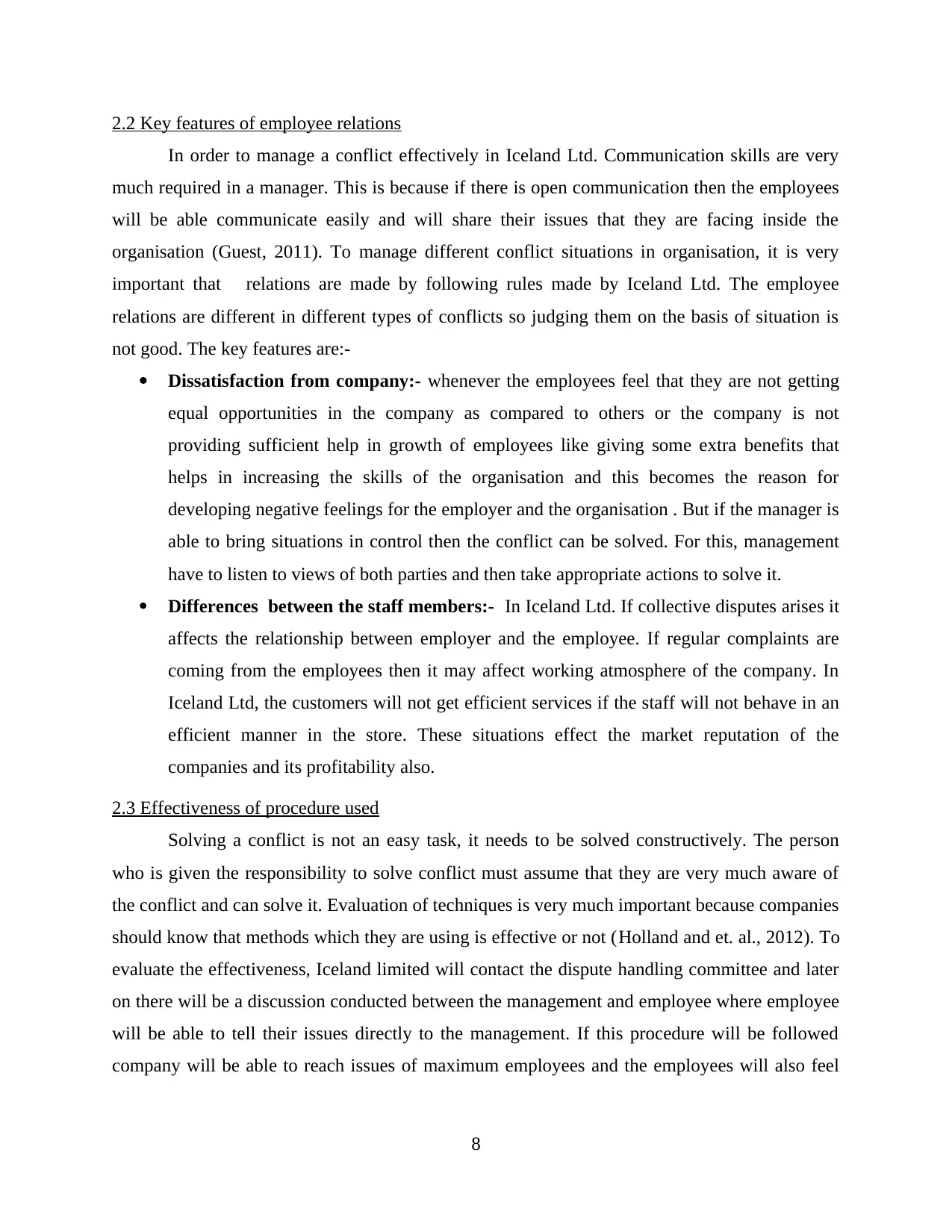
2.2 Key features of employee relations
In order to manage a conflict effectively in Iceland Ltd. Communication skills are very
much required in a manager. This is because if there is open communication then the employees
will be able communicate easily and will share their issues that they are facing inside the
organisation (Guest, 2011). To manage different conflict situations in organisation, it is very
important that relations are made by following rules made by Iceland Ltd. The employee
relations are different in different types of conflicts so judging them on the basis of situation is
not good. The key features are:-
Dissatisfaction from company:- whenever the employees feel that they are not getting
equal opportunities in the company as compared to others or the company is not
providing sufficient help in growth of employees like giving some extra benefits that
helps in increasing the skills of the organisation and this becomes the reason for
developing negative feelings for the employer and the organisation . But if the manager is
able to bring situations in control then the conflict can be solved. For this, management
have to listen to views of both parties and then take appropriate actions to solve it.
Differences between the staff members:- In Iceland Ltd. If collective disputes arises it
affects the relationship between employer and the employee. If regular complaints are
coming from the employees then it may affect working atmosphere of the company. In
Iceland Ltd, the customers will not get efficient services if the staff will not behave in an
efficient manner in the store. These situations effect the market reputation of the
companies and its profitability also.
2.3 Effectiveness of procedure used
Solving a conflict is not an easy task, it needs to be solved constructively. The person
who is given the responsibility to solve conflict must assume that they are very much aware of
the conflict and can solve it. Evaluation of techniques is very much important because companies
should know that methods which they are using is effective or not (Holland and et. al., 2012). To
evaluate the effectiveness, Iceland limited will contact the dispute handling committee and later
on there will be a discussion conducted between the management and employee where employee
will be able to tell their issues directly to the management. If this procedure will be followed
company will be able to reach issues of maximum employees and the employees will also feel
8
In order to manage a conflict effectively in Iceland Ltd. Communication skills are very
much required in a manager. This is because if there is open communication then the employees
will be able communicate easily and will share their issues that they are facing inside the
organisation (Guest, 2011). To manage different conflict situations in organisation, it is very
important that relations are made by following rules made by Iceland Ltd. The employee
relations are different in different types of conflicts so judging them on the basis of situation is
not good. The key features are:-
Dissatisfaction from company:- whenever the employees feel that they are not getting
equal opportunities in the company as compared to others or the company is not
providing sufficient help in growth of employees like giving some extra benefits that
helps in increasing the skills of the organisation and this becomes the reason for
developing negative feelings for the employer and the organisation . But if the manager is
able to bring situations in control then the conflict can be solved. For this, management
have to listen to views of both parties and then take appropriate actions to solve it.
Differences between the staff members:- In Iceland Ltd. If collective disputes arises it
affects the relationship between employer and the employee. If regular complaints are
coming from the employees then it may affect working atmosphere of the company. In
Iceland Ltd, the customers will not get efficient services if the staff will not behave in an
efficient manner in the store. These situations effect the market reputation of the
companies and its profitability also.
2.3 Effectiveness of procedure used
Solving a conflict is not an easy task, it needs to be solved constructively. The person
who is given the responsibility to solve conflict must assume that they are very much aware of
the conflict and can solve it. Evaluation of techniques is very much important because companies
should know that methods which they are using is effective or not (Holland and et. al., 2012). To
evaluate the effectiveness, Iceland limited will contact the dispute handling committee and later
on there will be a discussion conducted between the management and employee where employee
will be able to tell their issues directly to the management. If this procedure will be followed
company will be able to reach issues of maximum employees and the employees will also feel
8
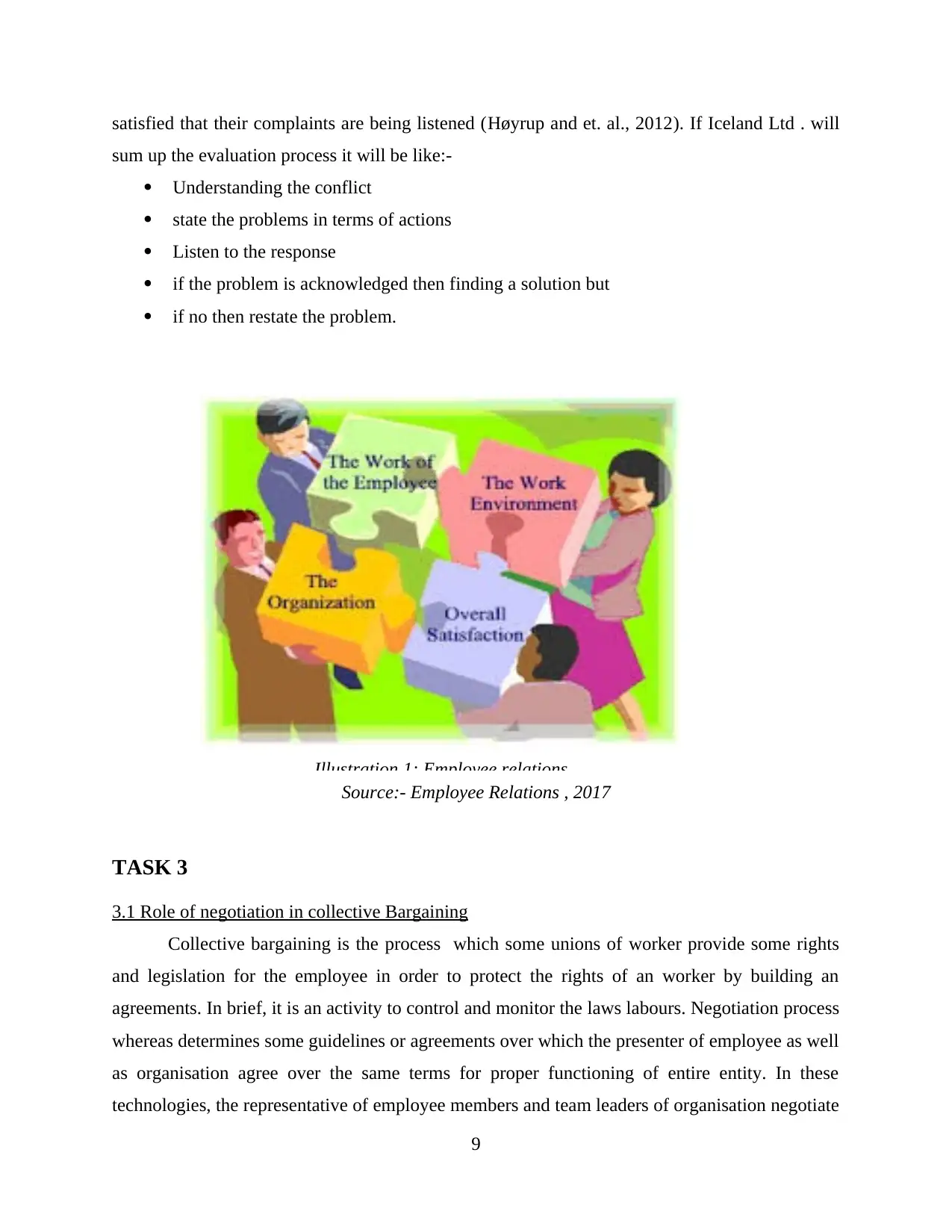
satisfied that their complaints are being listened (Høyrup and et. al., 2012). If Iceland Ltd . will
sum up the evaluation process it will be like:-
Understanding the conflict
state the problems in terms of actions
Listen to the response
if the problem is acknowledged then finding a solution but
if no then restate the problem.
Source:- Employee Relations , 2017
TASK 3
3.1 Role of negotiation in collective Bargaining
Collective bargaining is the process which some unions of worker provide some rights
and legislation for the employee in order to protect the rights of an worker by building an
agreements. In brief, it is an activity to control and monitor the laws labours. Negotiation process
whereas determines some guidelines or agreements over which the presenter of employee as well
as organisation agree over the same terms for proper functioning of entire entity. In these
technologies, the representative of employee members and team leaders of organisation negotiate
9
Illustration 1: Employee relations
sum up the evaluation process it will be like:-
Understanding the conflict
state the problems in terms of actions
Listen to the response
if the problem is acknowledged then finding a solution but
if no then restate the problem.
Source:- Employee Relations , 2017
TASK 3
3.1 Role of negotiation in collective Bargaining
Collective bargaining is the process which some unions of worker provide some rights
and legislation for the employee in order to protect the rights of an worker by building an
agreements. In brief, it is an activity to control and monitor the laws labours. Negotiation process
whereas determines some guidelines or agreements over which the presenter of employee as well
as organisation agree over the same terms for proper functioning of entire entity. In these
technologies, the representative of employee members and team leaders of organisation negotiate
9
Illustration 1: Employee relations
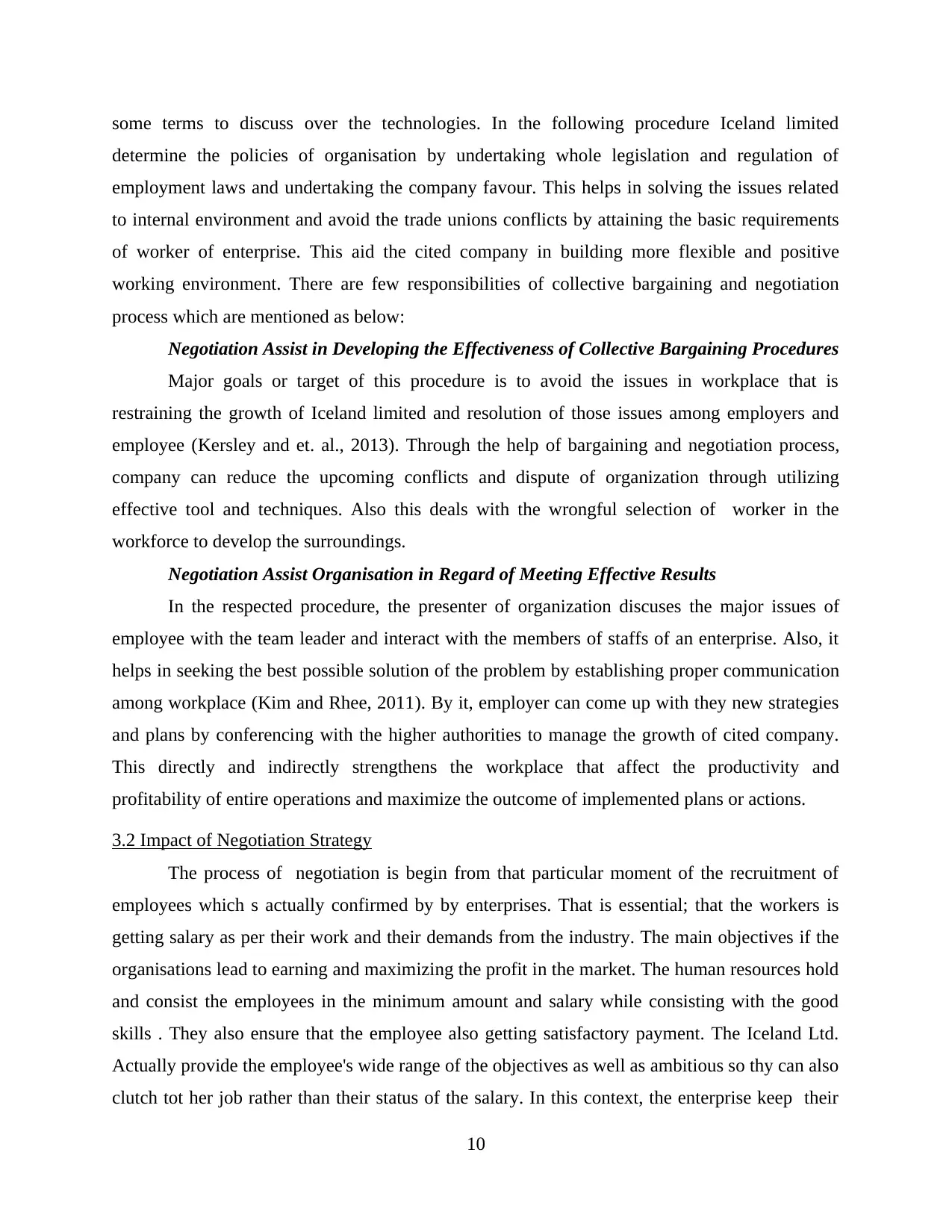
some terms to discuss over the technologies. In the following procedure Iceland limited
determine the policies of organisation by undertaking whole legislation and regulation of
employment laws and undertaking the company favour. This helps in solving the issues related
to internal environment and avoid the trade unions conflicts by attaining the basic requirements
of worker of enterprise. This aid the cited company in building more flexible and positive
working environment. There are few responsibilities of collective bargaining and negotiation
process which are mentioned as below:
Negotiation Assist in Developing the Effectiveness of Collective Bargaining Procedures
Major goals or target of this procedure is to avoid the issues in workplace that is
restraining the growth of Iceland limited and resolution of those issues among employers and
employee (Kersley and et. al., 2013). Through the help of bargaining and negotiation process,
company can reduce the upcoming conflicts and dispute of organization through utilizing
effective tool and techniques. Also this deals with the wrongful selection of worker in the
workforce to develop the surroundings.
Negotiation Assist Organisation in Regard of Meeting Effective Results
In the respected procedure, the presenter of organization discuses the major issues of
employee with the team leader and interact with the members of staffs of an enterprise. Also, it
helps in seeking the best possible solution of the problem by establishing proper communication
among workplace (Kim and Rhee, 2011). By it, employer can come up with they new strategies
and plans by conferencing with the higher authorities to manage the growth of cited company.
This directly and indirectly strengthens the workplace that affect the productivity and
profitability of entire operations and maximize the outcome of implemented plans or actions.
3.2 Impact of Negotiation Strategy
The process of negotiation is begin from that particular moment of the recruitment of
employees which s actually confirmed by by enterprises. That is essential; that the workers is
getting salary as per their work and their demands from the industry. The main objectives if the
organisations lead to earning and maximizing the profit in the market. The human resources hold
and consist the employees in the minimum amount and salary while consisting with the good
skills . They also ensure that the employee also getting satisfactory payment. The Iceland Ltd.
Actually provide the employee's wide range of the objectives as well as ambitious so thy can also
clutch tot her job rather than their status of the salary. In this context, the enterprise keep their
10
determine the policies of organisation by undertaking whole legislation and regulation of
employment laws and undertaking the company favour. This helps in solving the issues related
to internal environment and avoid the trade unions conflicts by attaining the basic requirements
of worker of enterprise. This aid the cited company in building more flexible and positive
working environment. There are few responsibilities of collective bargaining and negotiation
process which are mentioned as below:
Negotiation Assist in Developing the Effectiveness of Collective Bargaining Procedures
Major goals or target of this procedure is to avoid the issues in workplace that is
restraining the growth of Iceland limited and resolution of those issues among employers and
employee (Kersley and et. al., 2013). Through the help of bargaining and negotiation process,
company can reduce the upcoming conflicts and dispute of organization through utilizing
effective tool and techniques. Also this deals with the wrongful selection of worker in the
workforce to develop the surroundings.
Negotiation Assist Organisation in Regard of Meeting Effective Results
In the respected procedure, the presenter of organization discuses the major issues of
employee with the team leader and interact with the members of staffs of an enterprise. Also, it
helps in seeking the best possible solution of the problem by establishing proper communication
among workplace (Kim and Rhee, 2011). By it, employer can come up with they new strategies
and plans by conferencing with the higher authorities to manage the growth of cited company.
This directly and indirectly strengthens the workplace that affect the productivity and
profitability of entire operations and maximize the outcome of implemented plans or actions.
3.2 Impact of Negotiation Strategy
The process of negotiation is begin from that particular moment of the recruitment of
employees which s actually confirmed by by enterprises. That is essential; that the workers is
getting salary as per their work and their demands from the industry. The main objectives if the
organisations lead to earning and maximizing the profit in the market. The human resources hold
and consist the employees in the minimum amount and salary while consisting with the good
skills . They also ensure that the employee also getting satisfactory payment. The Iceland Ltd.
Actually provide the employee's wide range of the objectives as well as ambitious so thy can also
clutch tot her job rather than their status of the salary. In this context, the enterprise keep their
10
Secure Best Marks with AI Grader
Need help grading? Try our AI Grader for instant feedback on your assignments.
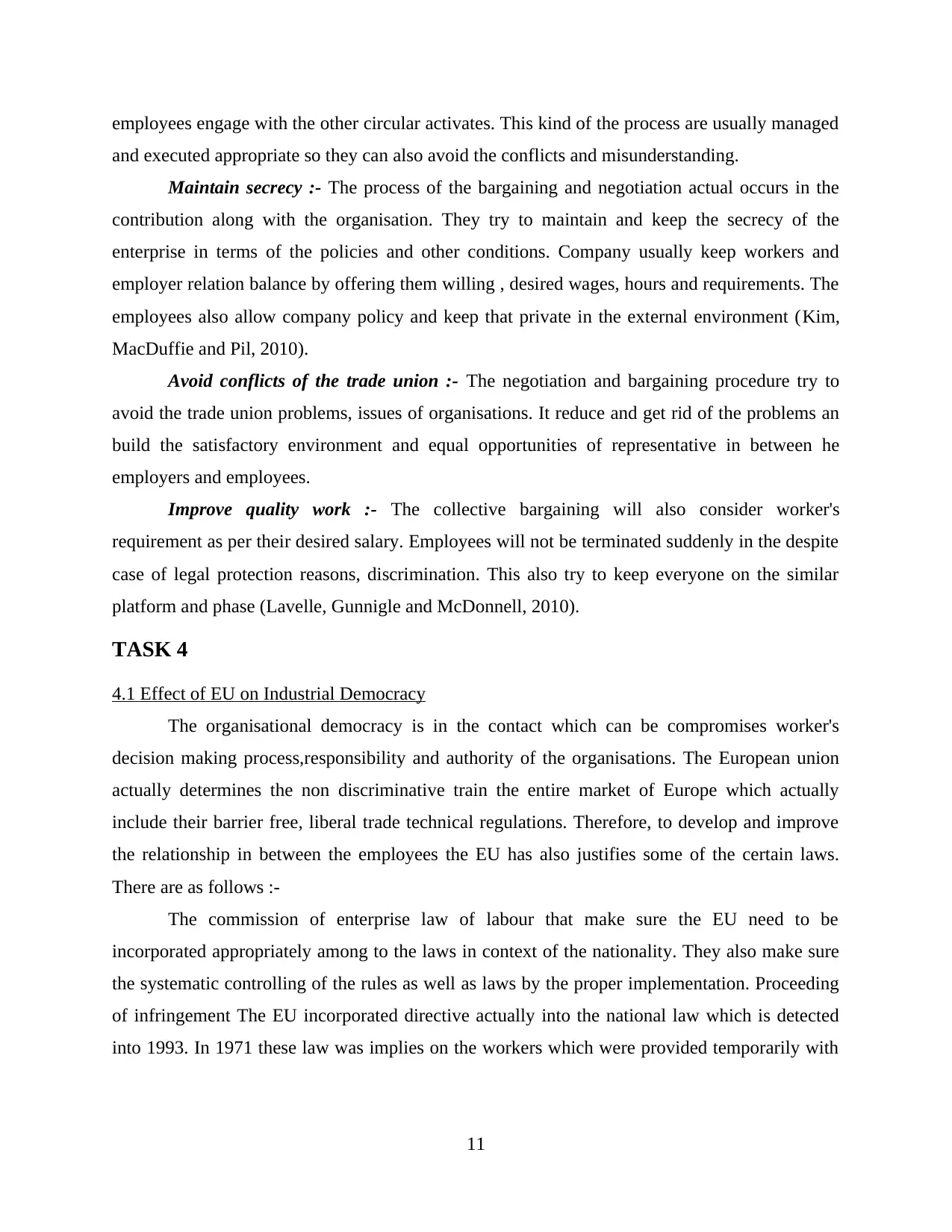
employees engage with the other circular activates. This kind of the process are usually managed
and executed appropriate so they can also avoid the conflicts and misunderstanding.
Maintain secrecy :- The process of the bargaining and negotiation actual occurs in the
contribution along with the organisation. They try to maintain and keep the secrecy of the
enterprise in terms of the policies and other conditions. Company usually keep workers and
employer relation balance by offering them willing , desired wages, hours and requirements. The
employees also allow company policy and keep that private in the external environment (Kim,
MacDuffie and Pil, 2010).
Avoid conflicts of the trade union :- The negotiation and bargaining procedure try to
avoid the trade union problems, issues of organisations. It reduce and get rid of the problems an
build the satisfactory environment and equal opportunities of representative in between he
employers and employees.
Improve quality work :- The collective bargaining will also consider worker's
requirement as per their desired salary. Employees will not be terminated suddenly in the despite
case of legal protection reasons, discrimination. This also try to keep everyone on the similar
platform and phase (Lavelle, Gunnigle and McDonnell, 2010).
TASK 4
4.1 Effect of EU on Industrial Democracy
The organisational democracy is in the contact which can be compromises worker's
decision making process,responsibility and authority of the organisations. The European union
actually determines the non discriminative train the entire market of Europe which actually
include their barrier free, liberal trade technical regulations. Therefore, to develop and improve
the relationship in between the employees the EU has also justifies some of the certain laws.
There are as follows :-
The commission of enterprise law of labour that make sure the EU need to be
incorporated appropriately among to the laws in context of the nationality. They also make sure
the systematic controlling of the rules as well as laws by the proper implementation. Proceeding
of infringement The EU incorporated directive actually into the national law which is detected
into 1993. In 1971 these law was implies on the workers which were provided temporarily with
11
and executed appropriate so they can also avoid the conflicts and misunderstanding.
Maintain secrecy :- The process of the bargaining and negotiation actual occurs in the
contribution along with the organisation. They try to maintain and keep the secrecy of the
enterprise in terms of the policies and other conditions. Company usually keep workers and
employer relation balance by offering them willing , desired wages, hours and requirements. The
employees also allow company policy and keep that private in the external environment (Kim,
MacDuffie and Pil, 2010).
Avoid conflicts of the trade union :- The negotiation and bargaining procedure try to
avoid the trade union problems, issues of organisations. It reduce and get rid of the problems an
build the satisfactory environment and equal opportunities of representative in between he
employers and employees.
Improve quality work :- The collective bargaining will also consider worker's
requirement as per their desired salary. Employees will not be terminated suddenly in the despite
case of legal protection reasons, discrimination. This also try to keep everyone on the similar
platform and phase (Lavelle, Gunnigle and McDonnell, 2010).
TASK 4
4.1 Effect of EU on Industrial Democracy
The organisational democracy is in the contact which can be compromises worker's
decision making process,responsibility and authority of the organisations. The European union
actually determines the non discriminative train the entire market of Europe which actually
include their barrier free, liberal trade technical regulations. Therefore, to develop and improve
the relationship in between the employees the EU has also justifies some of the certain laws.
There are as follows :-
The commission of enterprise law of labour that make sure the EU need to be
incorporated appropriately among to the laws in context of the nationality. They also make sure
the systematic controlling of the rules as well as laws by the proper implementation. Proceeding
of infringement The EU incorporated directive actually into the national law which is detected
into 1993. In 1971 these law was implies on the workers which were provided temporarily with
11
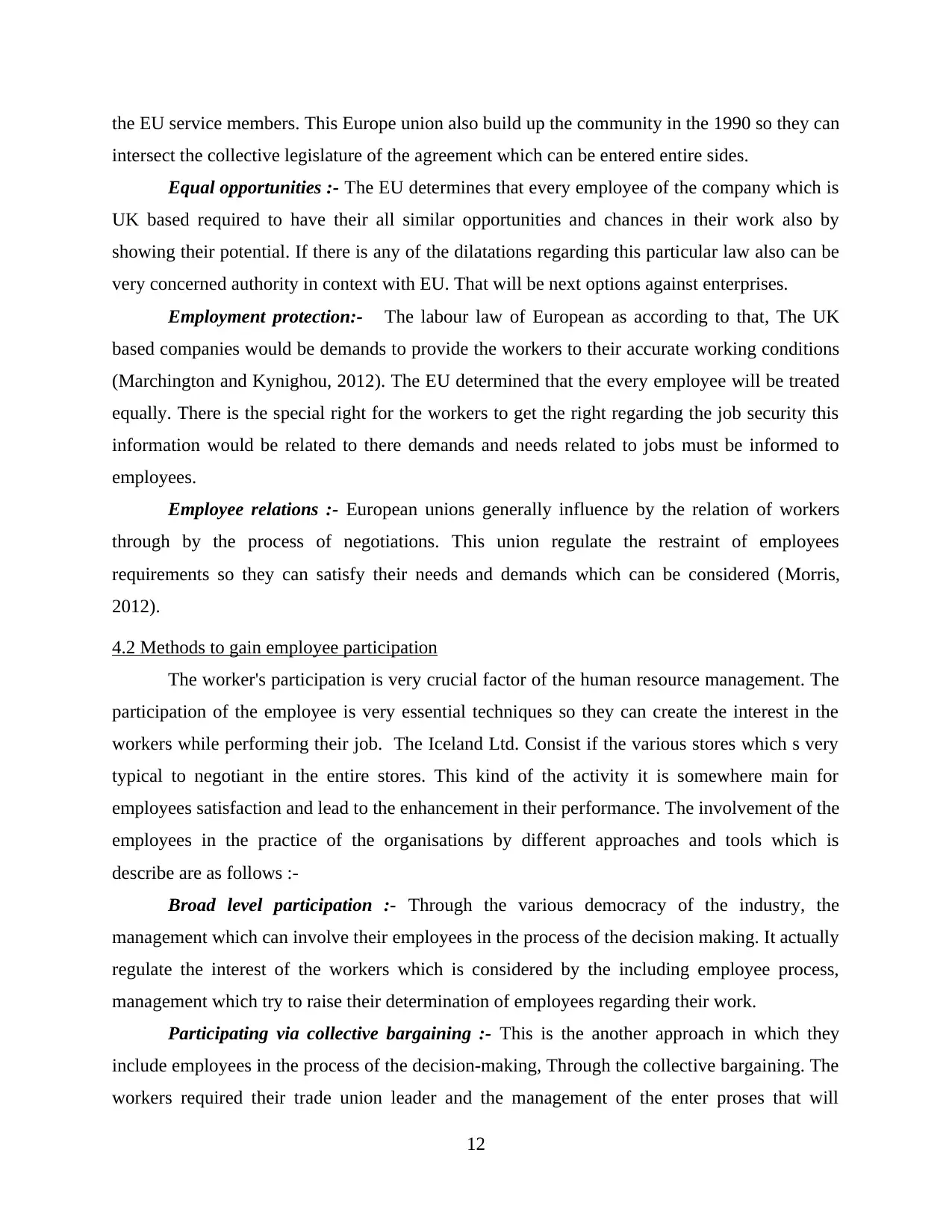
the EU service members. This Europe union also build up the community in the 1990 so they can
intersect the collective legislature of the agreement which can be entered entire sides.
Equal opportunities :- The EU determines that every employee of the company which is
UK based required to have their all similar opportunities and chances in their work also by
showing their potential. If there is any of the dilatations regarding this particular law also can be
very concerned authority in context with EU. That will be next options against enterprises.
Employment protection:- The labour law of European as according to that, The UK
based companies would be demands to provide the workers to their accurate working conditions
(Marchington and Kynighou, 2012). The EU determined that the every employee will be treated
equally. There is the special right for the workers to get the right regarding the job security this
information would be related to there demands and needs related to jobs must be informed to
employees.
Employee relations :- European unions generally influence by the relation of workers
through by the process of negotiations. This union regulate the restraint of employees
requirements so they can satisfy their needs and demands which can be considered (Morris,
2012).
4.2 Methods to gain employee participation
The worker's participation is very crucial factor of the human resource management. The
participation of the employee is very essential techniques so they can create the interest in the
workers while performing their job. The Iceland Ltd. Consist if the various stores which s very
typical to negotiant in the entire stores. This kind of the activity it is somewhere main for
employees satisfaction and lead to the enhancement in their performance. The involvement of the
employees in the practice of the organisations by different approaches and tools which is
describe are as follows :-
Broad level participation :- Through the various democracy of the industry, the
management which can involve their employees in the process of the decision making. It actually
regulate the interest of the workers which is considered by the including employee process,
management which try to raise their determination of employees regarding their work.
Participating via collective bargaining :- This is the another approach in which they
include employees in the process of the decision-making, Through the collective bargaining. The
workers required their trade union leader and the management of the enter proses that will
12
intersect the collective legislature of the agreement which can be entered entire sides.
Equal opportunities :- The EU determines that every employee of the company which is
UK based required to have their all similar opportunities and chances in their work also by
showing their potential. If there is any of the dilatations regarding this particular law also can be
very concerned authority in context with EU. That will be next options against enterprises.
Employment protection:- The labour law of European as according to that, The UK
based companies would be demands to provide the workers to their accurate working conditions
(Marchington and Kynighou, 2012). The EU determined that the every employee will be treated
equally. There is the special right for the workers to get the right regarding the job security this
information would be related to there demands and needs related to jobs must be informed to
employees.
Employee relations :- European unions generally influence by the relation of workers
through by the process of negotiations. This union regulate the restraint of employees
requirements so they can satisfy their needs and demands which can be considered (Morris,
2012).
4.2 Methods to gain employee participation
The worker's participation is very crucial factor of the human resource management. The
participation of the employee is very essential techniques so they can create the interest in the
workers while performing their job. The Iceland Ltd. Consist if the various stores which s very
typical to negotiant in the entire stores. This kind of the activity it is somewhere main for
employees satisfaction and lead to the enhancement in their performance. The involvement of the
employees in the practice of the organisations by different approaches and tools which is
describe are as follows :-
Broad level participation :- Through the various democracy of the industry, the
management which can involve their employees in the process of the decision making. It actually
regulate the interest of the workers which is considered by the including employee process,
management which try to raise their determination of employees regarding their work.
Participating via collective bargaining :- This is the another approach in which they
include employees in the process of the decision-making, Through the collective bargaining. The
workers required their trade union leader and the management of the enter proses that will
12
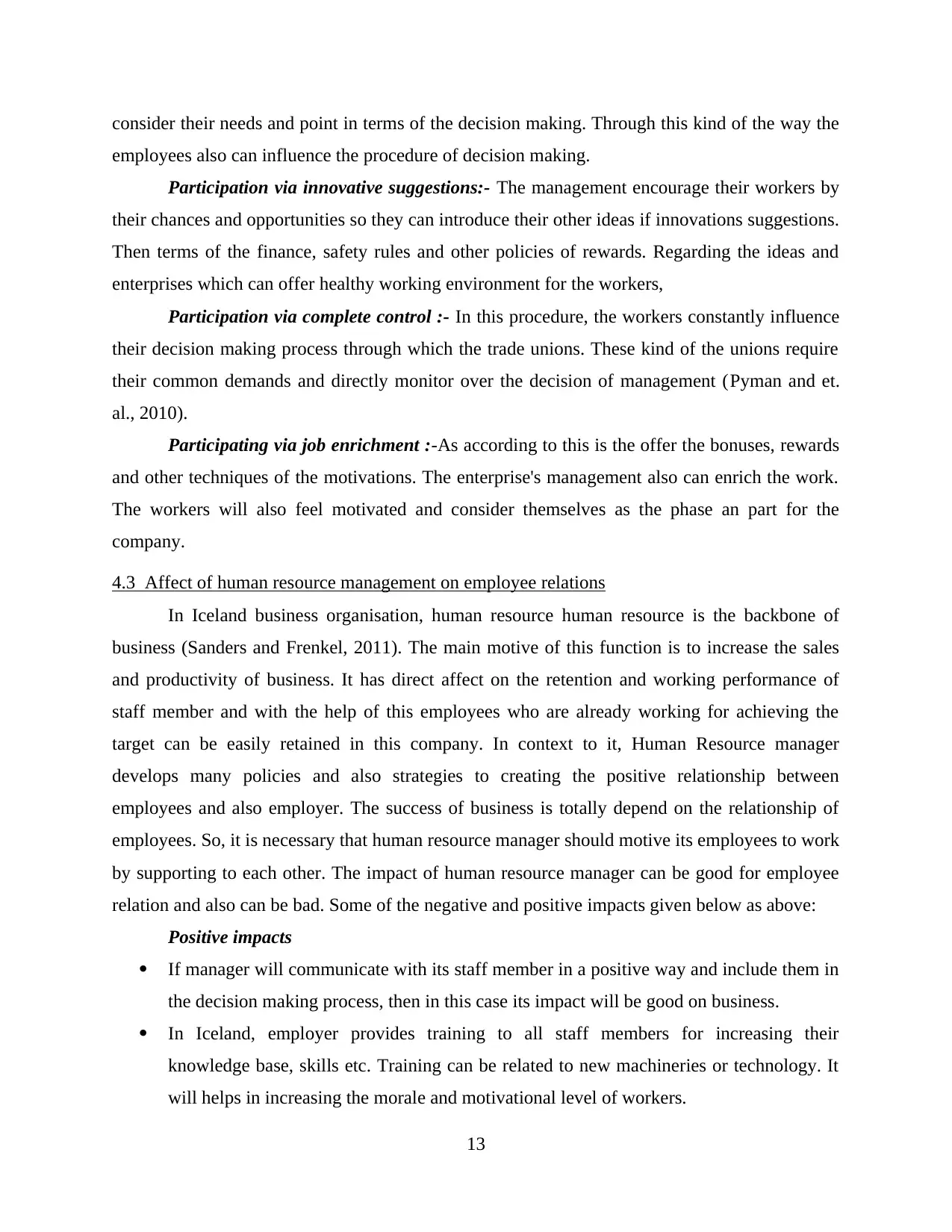
consider their needs and point in terms of the decision making. Through this kind of the way the
employees also can influence the procedure of decision making.
Participation via innovative suggestions:- The management encourage their workers by
their chances and opportunities so they can introduce their other ideas if innovations suggestions.
Then terms of the finance, safety rules and other policies of rewards. Regarding the ideas and
enterprises which can offer healthy working environment for the workers,
Participation via complete control :- In this procedure, the workers constantly influence
their decision making process through which the trade unions. These kind of the unions require
their common demands and directly monitor over the decision of management (Pyman and et.
al., 2010).
Participating via job enrichment :-As according to this is the offer the bonuses, rewards
and other techniques of the motivations. The enterprise's management also can enrich the work.
The workers will also feel motivated and consider themselves as the phase an part for the
company.
4.3 Affect of human resource management on employee relations
In Iceland business organisation, human resource human resource is the backbone of
business (Sanders and Frenkel, 2011). The main motive of this function is to increase the sales
and productivity of business. It has direct affect on the retention and working performance of
staff member and with the help of this employees who are already working for achieving the
target can be easily retained in this company. In context to it, Human Resource manager
develops many policies and also strategies to creating the positive relationship between
employees and also employer. The success of business is totally depend on the relationship of
employees. So, it is necessary that human resource manager should motive its employees to work
by supporting to each other. The impact of human resource manager can be good for employee
relation and also can be bad. Some of the negative and positive impacts given below as above:
Positive impacts
If manager will communicate with its staff member in a positive way and include them in
the decision making process, then in this case its impact will be good on business.
In Iceland, employer provides training to all staff members for increasing their
knowledge base, skills etc. Training can be related to new machineries or technology. It
will helps in increasing the morale and motivational level of workers.
13
employees also can influence the procedure of decision making.
Participation via innovative suggestions:- The management encourage their workers by
their chances and opportunities so they can introduce their other ideas if innovations suggestions.
Then terms of the finance, safety rules and other policies of rewards. Regarding the ideas and
enterprises which can offer healthy working environment for the workers,
Participation via complete control :- In this procedure, the workers constantly influence
their decision making process through which the trade unions. These kind of the unions require
their common demands and directly monitor over the decision of management (Pyman and et.
al., 2010).
Participating via job enrichment :-As according to this is the offer the bonuses, rewards
and other techniques of the motivations. The enterprise's management also can enrich the work.
The workers will also feel motivated and consider themselves as the phase an part for the
company.
4.3 Affect of human resource management on employee relations
In Iceland business organisation, human resource human resource is the backbone of
business (Sanders and Frenkel, 2011). The main motive of this function is to increase the sales
and productivity of business. It has direct affect on the retention and working performance of
staff member and with the help of this employees who are already working for achieving the
target can be easily retained in this company. In context to it, Human Resource manager
develops many policies and also strategies to creating the positive relationship between
employees and also employer. The success of business is totally depend on the relationship of
employees. So, it is necessary that human resource manager should motive its employees to work
by supporting to each other. The impact of human resource manager can be good for employee
relation and also can be bad. Some of the negative and positive impacts given below as above:
Positive impacts
If manager will communicate with its staff member in a positive way and include them in
the decision making process, then in this case its impact will be good on business.
In Iceland, employer provides training to all staff members for increasing their
knowledge base, skills etc. Training can be related to new machineries or technology. It
will helps in increasing the morale and motivational level of workers.
13
Paraphrase This Document
Need a fresh take? Get an instant paraphrase of this document with our AI Paraphraser
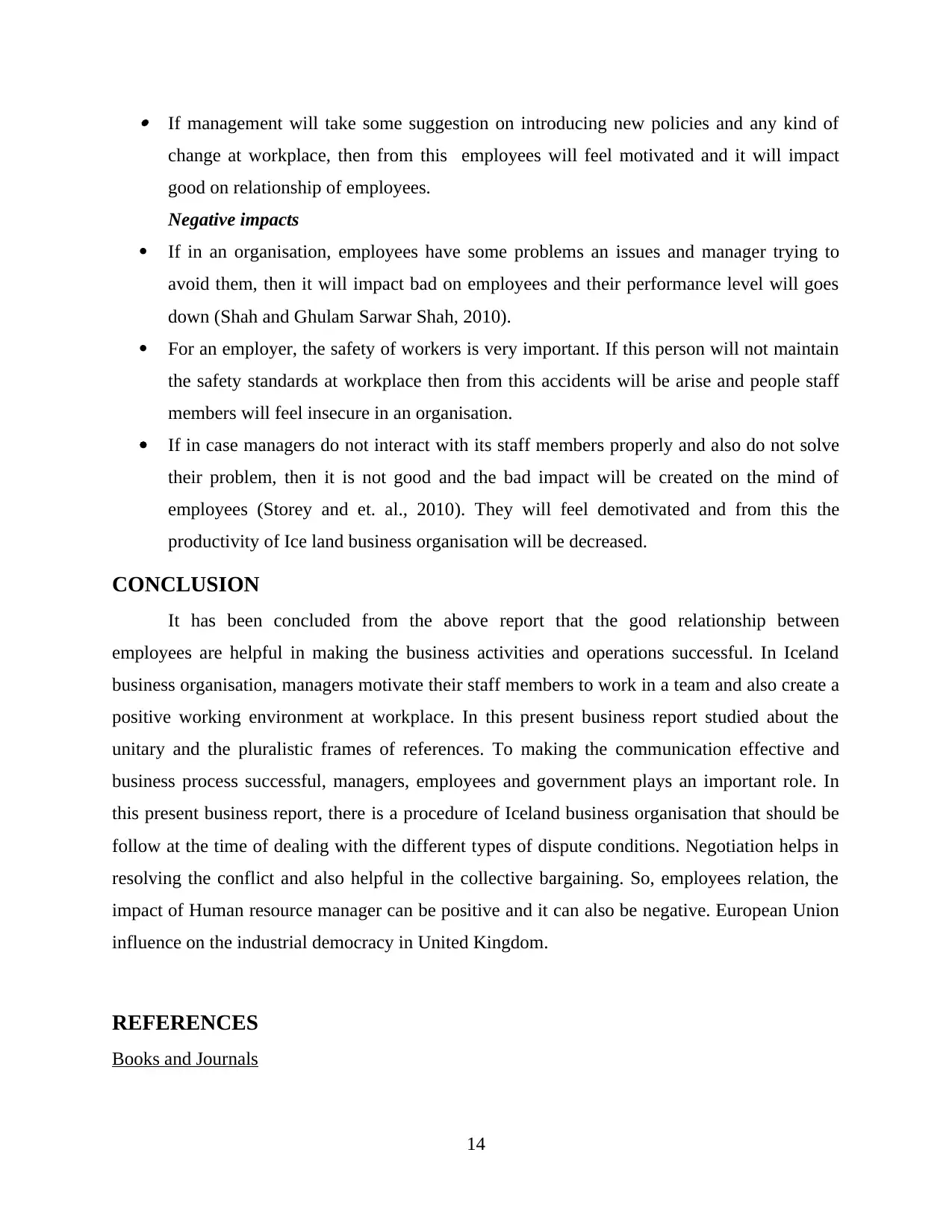
If management will take some suggestion on introducing new policies and any kind of
change at workplace, then from this employees will feel motivated and it will impact
good on relationship of employees.
Negative impacts
If in an organisation, employees have some problems an issues and manager trying to
avoid them, then it will impact bad on employees and their performance level will goes
down (Shah and Ghulam Sarwar Shah, 2010).
For an employer, the safety of workers is very important. If this person will not maintain
the safety standards at workplace then from this accidents will be arise and people staff
members will feel insecure in an organisation.
If in case managers do not interact with its staff members properly and also do not solve
their problem, then it is not good and the bad impact will be created on the mind of
employees (Storey and et. al., 2010). They will feel demotivated and from this the
productivity of Ice land business organisation will be decreased.
CONCLUSION
It has been concluded from the above report that the good relationship between
employees are helpful in making the business activities and operations successful. In Iceland
business organisation, managers motivate their staff members to work in a team and also create a
positive working environment at workplace. In this present business report studied about the
unitary and the pluralistic frames of references. To making the communication effective and
business process successful, managers, employees and government plays an important role. In
this present business report, there is a procedure of Iceland business organisation that should be
follow at the time of dealing with the different types of dispute conditions. Negotiation helps in
resolving the conflict and also helpful in the collective bargaining. So, employees relation, the
impact of Human resource manager can be positive and it can also be negative. European Union
influence on the industrial democracy in United Kingdom.
REFERENCES
Books and Journals
14
change at workplace, then from this employees will feel motivated and it will impact
good on relationship of employees.
Negative impacts
If in an organisation, employees have some problems an issues and manager trying to
avoid them, then it will impact bad on employees and their performance level will goes
down (Shah and Ghulam Sarwar Shah, 2010).
For an employer, the safety of workers is very important. If this person will not maintain
the safety standards at workplace then from this accidents will be arise and people staff
members will feel insecure in an organisation.
If in case managers do not interact with its staff members properly and also do not solve
their problem, then it is not good and the bad impact will be created on the mind of
employees (Storey and et. al., 2010). They will feel demotivated and from this the
productivity of Ice land business organisation will be decreased.
CONCLUSION
It has been concluded from the above report that the good relationship between
employees are helpful in making the business activities and operations successful. In Iceland
business organisation, managers motivate their staff members to work in a team and also create a
positive working environment at workplace. In this present business report studied about the
unitary and the pluralistic frames of references. To making the communication effective and
business process successful, managers, employees and government plays an important role. In
this present business report, there is a procedure of Iceland business organisation that should be
follow at the time of dealing with the different types of dispute conditions. Negotiation helps in
resolving the conflict and also helpful in the collective bargaining. So, employees relation, the
impact of Human resource manager can be positive and it can also be negative. European Union
influence on the industrial democracy in United Kingdom.
REFERENCES
Books and Journals
14
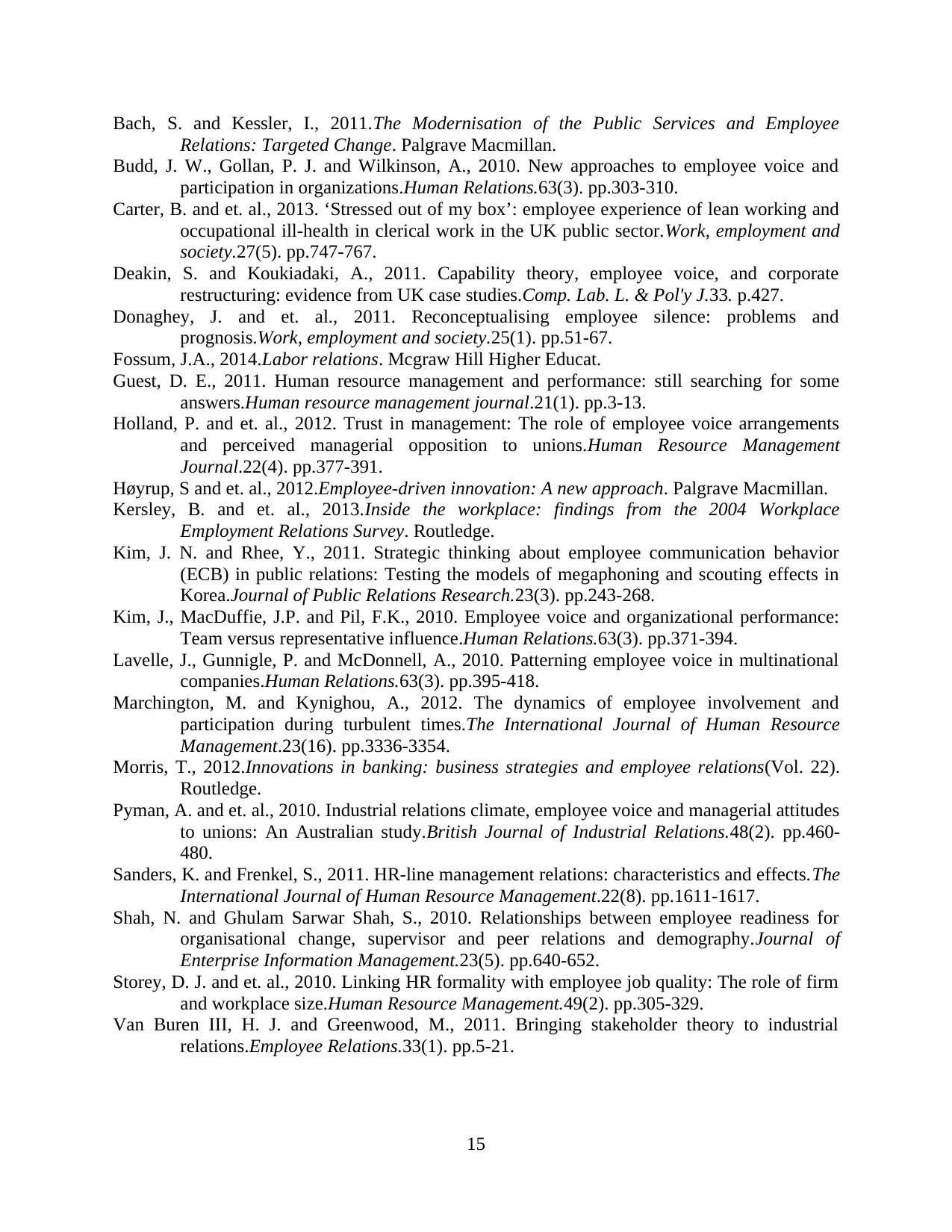
Bach, S. and Kessler, I., 2011.The Modernisation of the Public Services and Employee
Relations: Targeted Change. Palgrave Macmillan.
Budd, J. W., Gollan, P. J. and Wilkinson, A., 2010. New approaches to employee voice and
participation in organizations.Human Relations.63(3). pp.303-310.
Carter, B. and et. al., 2013. ‘Stressed out of my box’: employee experience of lean working and
occupational ill-health in clerical work in the UK public sector.Work, employment and
society.27(5). pp.747-767.
Deakin, S. and Koukiadaki, A., 2011. Capability theory, employee voice, and corporate
restructuring: evidence from UK case studies.Comp. Lab. L. & Pol'y J.33. p.427.
Donaghey, J. and et. al., 2011. Reconceptualising employee silence: problems and
prognosis.Work, employment and society.25(1). pp.51-67.
Fossum, J.A., 2014.Labor relations. Mcgraw Hill Higher Educat.
Guest, D. E., 2011. Human resource management and performance: still searching for some
answers.Human resource management journal.21(1). pp.3-13.
Holland, P. and et. al., 2012. Trust in management: The role of employee voice arrangements
and perceived managerial opposition to unions.Human Resource Management
Journal.22(4). pp.377-391.
Høyrup, S and et. al., 2012.Employee-driven innovation: A new approach. Palgrave Macmillan.
Kersley, B. and et. al., 2013.Inside the workplace: findings from the 2004 Workplace
Employment Relations Survey. Routledge.
Kim, J. N. and Rhee, Y., 2011. Strategic thinking about employee communication behavior
(ECB) in public relations: Testing the models of megaphoning and scouting effects in
Korea.Journal of Public Relations Research.23(3). pp.243-268.
Kim, J., MacDuffie, J.P. and Pil, F.K., 2010. Employee voice and organizational performance:
Team versus representative influence.Human Relations.63(3). pp.371-394.
Lavelle, J., Gunnigle, P. and McDonnell, A., 2010. Patterning employee voice in multinational
companies.Human Relations.63(3). pp.395-418.
Marchington, M. and Kynighou, A., 2012. The dynamics of employee involvement and
participation during turbulent times.The International Journal of Human Resource
Management.23(16). pp.3336-3354.
Morris, T., 2012.Innovations in banking: business strategies and employee relations(Vol. 22).
Routledge.
Pyman, A. and et. al., 2010. Industrial relations climate, employee voice and managerial attitudes
to unions: An Australian study.British Journal of Industrial Relations.48(2). pp.460-
480.
Sanders, K. and Frenkel, S., 2011. HR-line management relations: characteristics and effects.The
International Journal of Human Resource Management.22(8). pp.1611-1617.
Shah, N. and Ghulam Sarwar Shah, S., 2010. Relationships between employee readiness for
organisational change, supervisor and peer relations and demography.Journal of
Enterprise Information Management.23(5). pp.640-652.
Storey, D. J. and et. al., 2010. Linking HR formality with employee job quality: The role of firm
and workplace size.Human Resource Management.49(2). pp.305-329.
Van Buren III, H. J. and Greenwood, M., 2011. Bringing stakeholder theory to industrial
relations.Employee Relations.33(1). pp.5-21.
15
Relations: Targeted Change. Palgrave Macmillan.
Budd, J. W., Gollan, P. J. and Wilkinson, A., 2010. New approaches to employee voice and
participation in organizations.Human Relations.63(3). pp.303-310.
Carter, B. and et. al., 2013. ‘Stressed out of my box’: employee experience of lean working and
occupational ill-health in clerical work in the UK public sector.Work, employment and
society.27(5). pp.747-767.
Deakin, S. and Koukiadaki, A., 2011. Capability theory, employee voice, and corporate
restructuring: evidence from UK case studies.Comp. Lab. L. & Pol'y J.33. p.427.
Donaghey, J. and et. al., 2011. Reconceptualising employee silence: problems and
prognosis.Work, employment and society.25(1). pp.51-67.
Fossum, J.A., 2014.Labor relations. Mcgraw Hill Higher Educat.
Guest, D. E., 2011. Human resource management and performance: still searching for some
answers.Human resource management journal.21(1). pp.3-13.
Holland, P. and et. al., 2012. Trust in management: The role of employee voice arrangements
and perceived managerial opposition to unions.Human Resource Management
Journal.22(4). pp.377-391.
Høyrup, S and et. al., 2012.Employee-driven innovation: A new approach. Palgrave Macmillan.
Kersley, B. and et. al., 2013.Inside the workplace: findings from the 2004 Workplace
Employment Relations Survey. Routledge.
Kim, J. N. and Rhee, Y., 2011. Strategic thinking about employee communication behavior
(ECB) in public relations: Testing the models of megaphoning and scouting effects in
Korea.Journal of Public Relations Research.23(3). pp.243-268.
Kim, J., MacDuffie, J.P. and Pil, F.K., 2010. Employee voice and organizational performance:
Team versus representative influence.Human Relations.63(3). pp.371-394.
Lavelle, J., Gunnigle, P. and McDonnell, A., 2010. Patterning employee voice in multinational
companies.Human Relations.63(3). pp.395-418.
Marchington, M. and Kynighou, A., 2012. The dynamics of employee involvement and
participation during turbulent times.The International Journal of Human Resource
Management.23(16). pp.3336-3354.
Morris, T., 2012.Innovations in banking: business strategies and employee relations(Vol. 22).
Routledge.
Pyman, A. and et. al., 2010. Industrial relations climate, employee voice and managerial attitudes
to unions: An Australian study.British Journal of Industrial Relations.48(2). pp.460-
480.
Sanders, K. and Frenkel, S., 2011. HR-line management relations: characteristics and effects.The
International Journal of Human Resource Management.22(8). pp.1611-1617.
Shah, N. and Ghulam Sarwar Shah, S., 2010. Relationships between employee readiness for
organisational change, supervisor and peer relations and demography.Journal of
Enterprise Information Management.23(5). pp.640-652.
Storey, D. J. and et. al., 2010. Linking HR formality with employee job quality: The role of firm
and workplace size.Human Resource Management.49(2). pp.305-329.
Van Buren III, H. J. and Greenwood, M., 2011. Bringing stakeholder theory to industrial
relations.Employee Relations.33(1). pp.5-21.
15
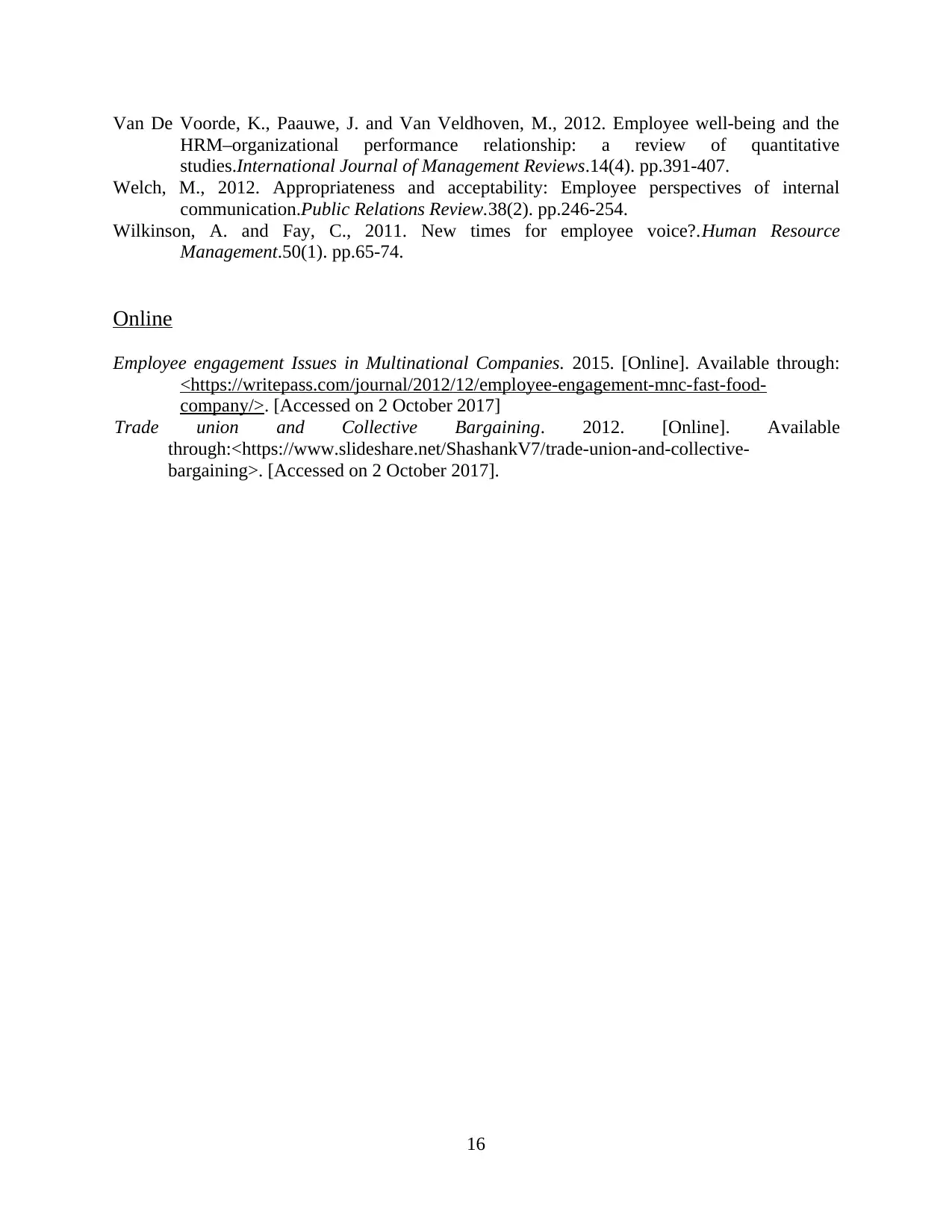
Van De Voorde, K., Paauwe, J. and Van Veldhoven, M., 2012. Employee well‐being and the
HRM–organizational performance relationship: a review of quantitative
studies.International Journal of Management Reviews.14(4). pp.391-407.
Welch, M., 2012. Appropriateness and acceptability: Employee perspectives of internal
communication.Public Relations Review.38(2). pp.246-254.
Wilkinson, A. and Fay, C., 2011. New times for employee voice?.Human Resource
Management.50(1). pp.65-74.
Online
Employee engagement Issues in Multinational Companies. 2015. [Online]. Available through:
<https://writepass.com/journal/2012/12/employee-engagement-mnc-fast-food-
company/>. [Accessed on 2 October 2017]
Trade union and Collective Bargaining. 2012. [Online]. Available
through:<https://www.slideshare.net/ShashankV7/trade-union-and-collective-
bargaining>. [Accessed on 2 October 2017].
16
HRM–organizational performance relationship: a review of quantitative
studies.International Journal of Management Reviews.14(4). pp.391-407.
Welch, M., 2012. Appropriateness and acceptability: Employee perspectives of internal
communication.Public Relations Review.38(2). pp.246-254.
Wilkinson, A. and Fay, C., 2011. New times for employee voice?.Human Resource
Management.50(1). pp.65-74.
Online
Employee engagement Issues in Multinational Companies. 2015. [Online]. Available through:
<https://writepass.com/journal/2012/12/employee-engagement-mnc-fast-food-
company/>. [Accessed on 2 October 2017]
Trade union and Collective Bargaining. 2012. [Online]. Available
through:<https://www.slideshare.net/ShashankV7/trade-union-and-collective-
bargaining>. [Accessed on 2 October 2017].
16
1 out of 16
Related Documents
Your All-in-One AI-Powered Toolkit for Academic Success.
+13062052269
info@desklib.com
Available 24*7 on WhatsApp / Email
![[object Object]](/_next/static/media/star-bottom.7253800d.svg)
Unlock your academic potential
© 2024 | Zucol Services PVT LTD | All rights reserved.





